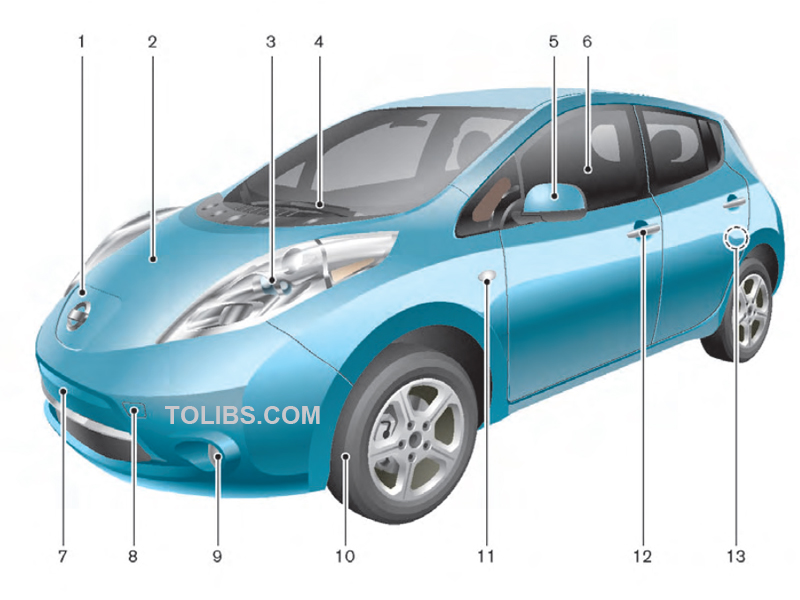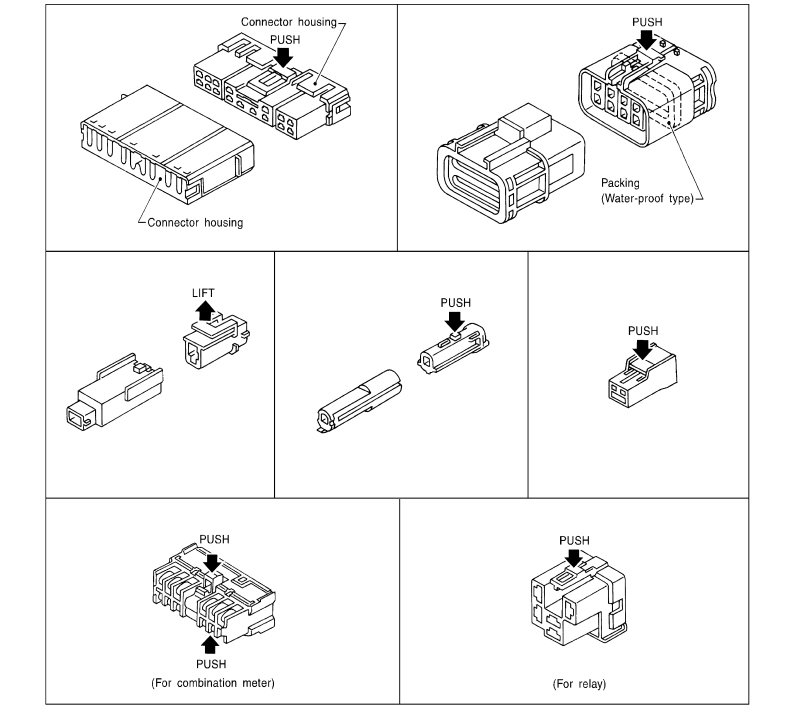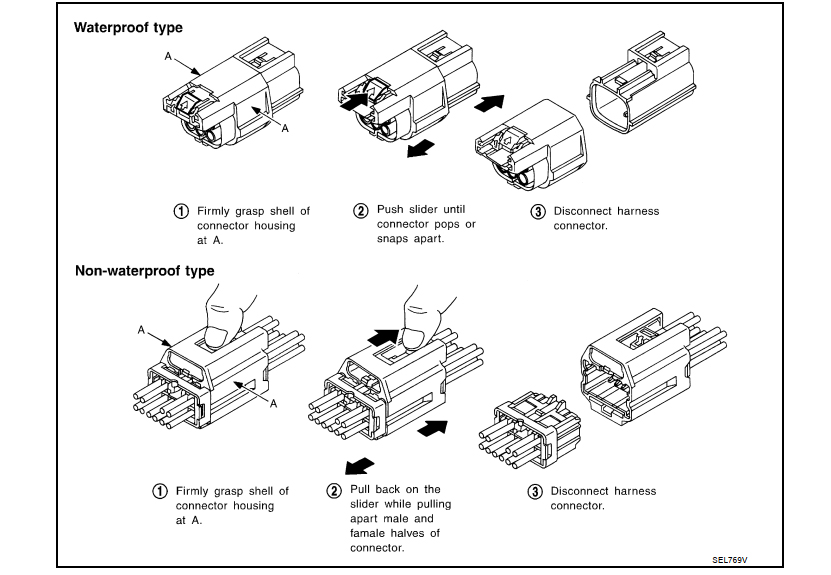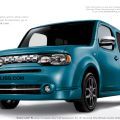Nissan Leaf Factory Service Repair Manuals

THE EV (Electric Vehicle) SYSTEM
The NISSAN LEAF is an electric vehicle. Some of the vehicle’s systems operate differently and have different operating characteristics than vehicles equipped with an internal combustion engine. It is important to carefully review the entire Owner’s Manual for this reason. The main difference is the LEAF is powered by electricity. The LEAF does not require and it is not capable of using gasoline like a vehicle powered by a traditional internal combustion engine. The LEAF uses electricity stored in the lithium ion (Li-ion) battery. The vehicle Li-ion battery must be charged with electricity before the vehicle can be driven. As the vehicle operates, the Li-ion battery gradually discharges. If the Li-ion battery becomes completely discharged, the vehicle will not operate until it is re-charged. The charging process usually takes from approximately 30 minutes to 21 hours as described more fully in this manual.
This vehicle uses two types of batteries. One is the 12-volt battery that is the same as the battery in vehicles powered by gasoline engines, the other is the Li-ion battery (high voltage). The 12-volt battery provides power to the vehicle systems and features such as the audio system, supplemental restraint systems, headlights and windshield wipers.
The Li-ion battery provides power to the electric motor (traction motor) that moves the vehicle. The Li-ion battery also charges the 12-volt battery.
The vehicle must be plugged in for the Li-ion battery to be charged. Additionally, the vehicle system can extend the vehicle range by converting driving force into electricity that is stored in the Li-ion battery while the vehicle is decelerating or being driven downhill. This is called regenerative brake. This vehicle is considered to be an environmentally friendly vehicle because it does not emit exhaust gases, such as carbon dioxide and nitrogen oxide.
COMPONENT PARTS
Circuit Breaker
The PTC thermistor generates heat in response to current flow. The temperature (and resistance) of the thermistor element varies with current flow. Excessive current flow will cause the element's temperature to rise. When the temperature reaches a specified level, the electrical resistance will rise sharply to control the circuit current. Reduced current flow will cause the element to cool. Resistance falls accordingly and normal circuit current flow is allowed to resume.
HARNESS CONNECTOR (SLIDE-LOCKING TYPE)

- A new style slide-locking type connector is used on certain systems and components, especially those related to OBD.
- The slide-locking type connectors help prevent incomplete locking and accidental looseness or disconnection.
- The slide-locking type connectors are disconnected by pushing or pulling the slider. Refer to the figure below.
- After connecting the connector, check that the slider is located in the correct position.
HARNESS CONNECTOR (LEVER LOCKING TYPE)

- Lever locking type harness connectors are used on certain control units and control modules such as ECM, ABS actuator and electric unit (control unit), etc.
- Lever locking type harness connectors are also used on super multiple junction (SMJ) connectors.
- Always confirm the lever is fully locked in place by moving the lever as far as it will go to ensure full connection.
Always confirm the lever is fully released (loosened) before attempting to disconnect or connect these connectors to avoid damage to the connector housing or terminals.
BODY CONTROL SYSTEM
- BCM (Body Control Module) controls the various electrical components. It inputs the information required to the control from CAN communication and the signal received from each switch and sensor.
- BCM has combination switch reading function for reading the operation status of combination switches (light, turn signal, wiper and washer) in addition to a function for controlling the operation of various electrical components. It also has the signal transmission function as the passed point of signal and the power saving control function that reduces the power consumption with the power switch OFF.
- BCM is equipped with the diagnosis function that performs the diagnosis with CONSULT and various settings
Sleep condition
- Receiving the sleep-ready signal (ready) from all units
- 1 minute after turning power switch OFF
- Theft warning alarm and panic alarm: Not operation
- Warning chime: Not operation
- Intelligent Key system buzzer: Not operation
- Stop lamp switch: OFF
- Turn signal indicator lamp: Not operation
- Exterior lamp: OFF
- Door lock status: No change
- CONSULT communication status: Not communication
- Meter display signal: Non-transmission
- Door switch status: No change
- Driver door lock status: No change
BCM sleep condition
- Interior room lamp battery saver: Time out*
- RAP system: Not operation
- Nissan Vehicle Immobilizer System (NVIS) - NATS: Not operation
- Remote keyless entry receiver communication status: No communication
- Tire pressurer monitoring system (TPMS): Stop
- ACC/ON indicator lamp: Not operation
Wake-up operation
BCM transmits sleep wake up signal (wake up) to each unit when any condition listed below is established, and then goes into normal mode from low power consumption mode. Each unit starts transmissions with CAN communication by receiving sleep wake up signals. Each unit transmit wake up signals to BCM with CAN communication to convey the start of CAN communication.
Wake-up condition
- Receiving the sleep-ready signal (Not-ready) from any units
- Power switch (push switch): OFF→ ON
- Hazard switch: ON
- HI BEAM switch: OFF → ON, ON → OFF
- PASSING switch: OFF → ON, ON → OFF
- HEADLAMP 1 switch: OFF → ON, ON → OFF
- HEADLAMP 2 switch: OFF → ON, ON → OFF
- TAIL LAMP switch: OFF → ON
- FR FOG switch: OFF → ON, ON → OFF
- TURN RH: OFF → ON, ON → OFF
- TURN LH: OFF → ON, ON → OFF
- Driver door switch: OFF → ON, ON → OFF
- Passenger door switch: OFF → ON, ON → OFF
- Rear RH door switch: OFF → ON, ON → OFF
- Rear LH door switch: OFF → ON, ON → OFF
- Back door switch: OFF → ON, ON → OFF
- Driver door request switch: OFF → ON
- Passenger door request switch: OFF → ON
- Back door request switch: OFF → ON
- Back door opener switch: OFF → ON
- Stop lamp switch: ON
- Door lock and unlock switch: NEUTRAL → LOCK, NEUTRAL → UNLOCK
- Front door lock assembly (driver side) (door key cylinder switch): NEUTRAL → LOCK, NEUTRAL → UNLOCK
- Remote keyless entry receiver communication: Receiving
- Front door lock assembly (driver side) (unlock sensor): OFF → ON, ON → OFF












